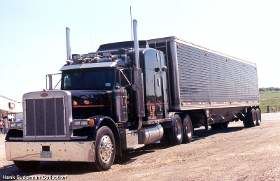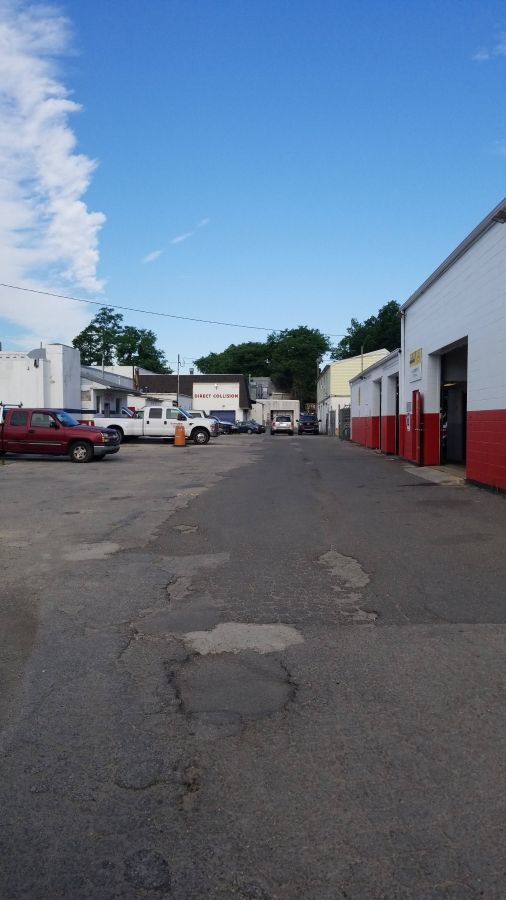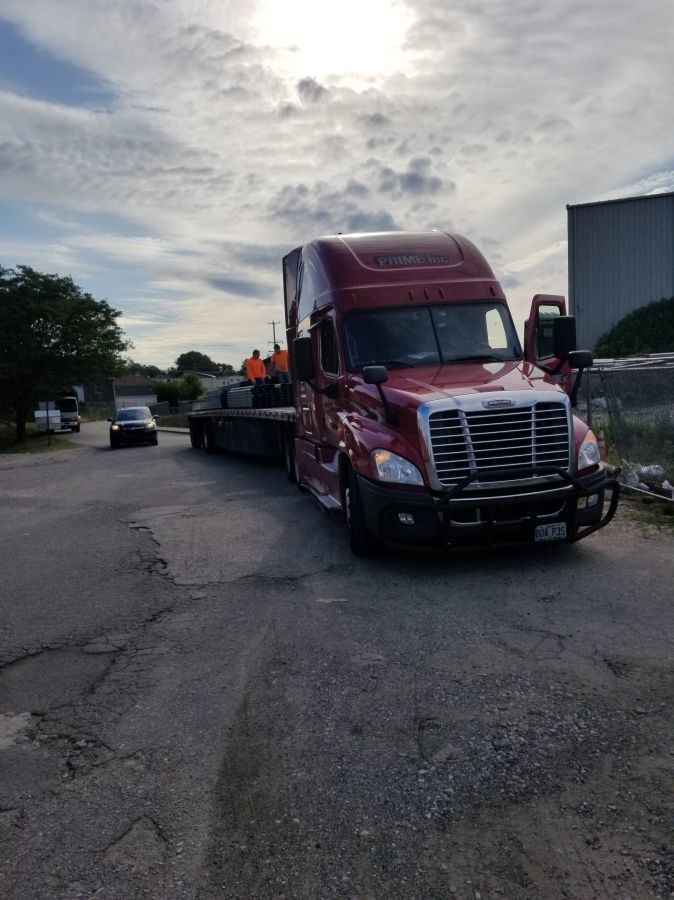The More I Ask The Less I Know
Topic 28433 | Page 2

I applied (I think) on the site. Along with being a total klutz as a new driver I'm also living in the stone ages re computers. Some of us that have a few years on us are not real computer friendly. I'm pretty sure I did it all correctly .
How many companies does my info go out to?
Is this the best way to reach out for a job?
Prime CRST Wilson Logistics Roehl Transport TMC Transport Millis Transfer Veriha Trucking PAM Transport are the companies your application goes out to. There are other companies that hire CDL grads such as Swift, Schneider, CR England, CFI, Werner that you can apply to separately. Wait for some offers to roll in then compare your options. Keep in mind CRST is ALL team, and TMC is ALL flatbed.
CDL:
Commercial Driver's License (CDL)
A CDL is required to drive any of the following vehicles:
- Any combination of vehicles with a gross combined weight rating (GCWR) of 26,001 or more pounds, providing the gross vehicle weight rating (GVWR) of the vehicle being towed is in excess of 10,000 pounds.
- Any single vehicle with a GVWR of 26,001 or more pounds, or any such vehicle towing another not in excess of 10,000 pounds.
- Any vehicle, regardless of size, designed to transport 16 or more persons, including the driver.
- Any vehicle required by federal regulations to be placarded while transporting hazardous materials.

Rob
You bring up an interesting subject. Flatbed? Is there an advantage? I had an instructor that suggested flatbed.
Pros? Cons?
Seems that there are those who prefer flatbed
HOS:
Hours Of Service
HOS refers to the logbook hours of service regulations.I've never done flatbed so I cant speak from personal experience but it seems for most that do it's something they really enjoy. Personally I'm not a big fan of the idea of tarping a load in 50 mph wind gusts in a snow and ice storm (like Old Schools picture). Some guys take pride over how well their load looks tarped going down the highway and the challenge involved in securing it with enough straps that will hold that weight. Hopefully some of our flatbedders can chime in later with some of the things they enjoy about it.

More interesting points you bring.
The instructor that suggested to me flatbed I answered with exactly what you bring up, tarping and the like.
I had made a wisecrack to him having to do with my backing skills asking if I could apply to a company that only required going forward. His answer was Flatbeds. When he answered that I did comment as to tarping and the like. In my over fifty year profession I drove an automobile about 100,000 miles a year. Pretty much all over the U.S. Of A and some in Ontario. Over those years and miles certainly I saw flatbeds that were tarped in weather that I sure wouldn't want to be tarping and tieing down a load, The instructor we had in our initial classroom week was a many year driver that only did flatbeds. I guess a flatbed driver is a dedicated kinda flatbed guy?
HOS:
Hours Of Service
HOS refers to the logbook hours of service regulations.Mike C,
As far as flatbed, I can share what I've learned in a short period of time (two months flatbed TNT).
1. The work is not as hard as you might think. I just had a discussion with another flatbedder that we were both a little disappointed that the work is not that physically demanding. That being said, tarps are heavy and tarping in adverse conditions sucks. Prime has these "yard tarps" which are bigger and can cover a load with just two tarps. They probably weigh about 120 lbs. Getting one of those on your shoulder is a struggle and just walking with it on your shoulder is hard. While I haven't experienced a windy winter day, my trainer had to add a tarp to our load in a torrential downpour. Not fun. However, there are some techniques that help make the work easier and pretty much every forklift operator will lift your tarps for you.
2. Wait times at shippers and receivers is less. The only time we have to wait is at the bigger places where there is a line of flatbeds coming in and out, so you've got to wait for the guy in front of you to get finished. At one particular receiver, when we set the brakes, the forklift operator came walking out of the shop saying "heard the air brakes and know what that means. I'll get the forklift while you unstrap." Now you do have to secure the load and strapping and tarping can take a while, but nothing like the 6 or 8 hours some of the dry van or reefer folks have shared.
3. Load volume is higher. DAT Load board shows over 26 loads per available truck:
DAT Flatbed Load Demand and Capacity
Dry van and reefer is about 1/5 of that load volume.
I'm on home time from TNT right now and got a message from dispatch saying they need trucks, when are we coming back.
We're never "pre-planned" because we don't need to be. I think the longest we've waited for a new load assignment was 2 hours. Usually, we have a new load assignment before we even get to the closest truck stop after we send out empty message.
4. Don't drive flatbed as a way to avoid backing. While we generally don't have to back that much or maneuver into tight spots, you will encounter some really difficult spaces. Several of our loads have been to construction sites in residential areas where you have to navigate tight intersections, back down a street, or turn around in spaces not designed for trucks at all.
Below are some pictures of our truck at a receiver and the space where we had to navigate.


5. You have more control over how your load is secured. Papa Pig posted about how some of the product that was loaded on his trailer had shifted. With flatbed you secure everything, so good securement is completely in your control. Also, because you're so intimately involved in the securement, you get a better idea of weight distribution (including top heaving loads).
6. Flatbedders are a different breed, in the sense that we're a little off in the head. If you were sniffing the rubber cement in art class while others were cutting out their poster board, you might be a good candidate for flatbedding. Flatbedders also tend to like challenges. Sometimes you get some weird stuff to secure and it's a puzzle to figure out the securement.
All in all, I am really enjoying the flatbed work. I have no desire to got to dry van or reefer.
I'm sure Turtle or Old School will chime in as well, as they have a whole lot more experience than me.
Shipper:
The customer who is shipping the freight. This is where the driver will pick up a load and then deliver it to the receiver or consignee.
SAP:
Substance Abuse Professional
The Substance Abuse Professional (SAP) is a person who evaluates employees who have violated a DOT drug and alcohol program regulation and makes recommendations concerning education, treatment, follow-up testing, and aftercare.
Dry Van:
A trailer or truck that that requires no special attention, such as refrigeration, that hauls regular palletted, boxed, or floor-loaded freight. The most common type of trailer in trucking.Reefer:
A refrigerated trailer.
HOS:
Hours Of Service
HOS refers to the logbook hours of service regulations.TNT:
Trainer-N-Trainee
Prime Inc has their own CDL training program and it's divided into two phases - PSD and TNT.
The PSD (Prime Student Driver) phase is where you'll get your permit and then go on the road for 10,000 miles with a trainer. When you come back you'll get your CDL license and enter the TNT phase.
The TNT phase is the second phase of training where you'll go on the road with an experienced driver for 30,000 miles of team driving. You'll receive 14¢ per mile ($700 per week guaranteed) during this phase. Once you're finished with TNT training you will be assigned a truck to run solo.
Rob D have you found the weights shippers provide you to be pretty accurate? Its not uncommon with reefer loads I've picked up paperwork claims its only 30,000 pounds of product but I'm pushing 80,000 gross. How do you ensure you have atleast the minimum securement required? I'm just referring to the weight side of the securement formula.
Shipper:
The customer who is shipping the freight. This is where the driver will pick up a load and then deliver it to the receiver or consignee.
Reefer:
A refrigerated trailer.
You bring up an interesting subject. Flatbed? Is there an advantage? I had an instructor that suggested flatbed.
Pros? Cons?
Mike, I'm a longtime flatbedder - I love it!
As many times as you've mentioned to us that you're a klutz and that you need time to learn new things, I think you should start with dry-van. Flatbed work adds so many other factors into your learning curve. To me, it doesn't seem prudent for your situation.
By the way, only drivers who have never driven a flatbed believe that silly lie that says flatbedders don't have to have backing skills. All truck drivers have to develop backing skills.
Rob D have you found the weights shippers provide you to be pretty accurate? Its not uncommon with reefer loads I've picked up paperwork claims its only 30,000 pounds of product but I'm pushing 80,000 gross. How do you ensure you have atleast the minimum securement required? I'm just referring to the weight side of the securement formula.
Rob,
Most of our loads have a detailed list of the items shipped and the weights listed for each item. These weights tend to be very spot on and are summed up in the total weight. Also, a lot of the product we haul is very much industry standard type of product so there is very little variance in the actual weight. Like the slinkies are pretty much standard size, shape, and weight. In addition, many of our industrial sites have you scale in before you load and scale out when you leave. So you know exactly your total weight is when you leave.
The only real issue that I've run into involves the weight distribution on the trailer as opposed to the drive axles. As I had posted on my diary, I weighed one trailer that was 37,000 lbs on the "tandems." Unlike dry van or reefer, we've got the spread axles. So to fix this overweight condition, I simply spread the axles, which gives me 20,000 lbs per axle at that point. Theoretically, I could have had 21,000 lbs on the front axle and only 16,000 lbs on the back axle, but they would have to REALLY want to be anal at a weigh station to get me to stop in such a way that I've only got one axle at a time on the scale.
As far as weight and securement, for the most part you are generally over the minimum working load limit simply by the nature of the number of straps needed per bundle as follows. Empty, we weigh 31,000 lbs. So our maximum load is 49,000 lbs. You need two straps in the first five feet, then one for each ten feet thereafter. Turtle, puts two up from and two in the back and then fills in the middle. So just basic strapping you've got at least 7 straps. At 5,000 lbs working load limit per strap, you've got 35,000 lbs working load limit. Add one more strap (which takes 5 minutes) and you're at 40,000 lbs working load limit, which equals the 80% working load limit you need for forward movement. But we generally have more because of the "bundles." You put two straps on each bundle, and then with Charlotte Pipe, you've got belly straps as well. So it's not uncommon to have 10-15 straps or more on a load that weighs 45,000. With 10 straps, I've got 50,000 lbs of working load limit for 45,000 lbs.
Same thing with stuff like Bobcats. They weigh less than 10,000 lbs. You need two chains at 5,000 lbs WLL each. So Again you're at 100% or more WLL.
Shipper:
The customer who is shipping the freight. This is where the driver will pick up a load and then deliver it to the receiver or consignee.
Tandems:
Tandem Axles
A set of axles spaced close together, legally defined as more than 40 and less than 96 inches apart by the USDOT. Drivers tend to refer to the tandem axles on their trailer as just "tandems". You might hear a driver say, "I'm 400 pounds overweight on my tandems", referring to his trailer tandems, not his tractor tandems. Tractor tandems are generally just referred to as "drives" which is short for "drive axles".
Tandem:
Tandem Axles
A set of axles spaced close together, legally defined as more than 40 and less than 96 inches apart by the USDOT. Drivers tend to refer to the tandem axles on their trailer as just "tandems". You might hear a driver say, "I'm 400 pounds overweight on my tandems", referring to his trailer tandems, not his tractor tandems. Tractor tandems are generally just referred to as "drives" which is short for "drive axles".
Dry Van:
A trailer or truck that that requires no special attention, such as refrigeration, that hauls regular palletted, boxed, or floor-loaded freight. The most common type of trailer in trucking.Reefer:
A refrigerated trailer.
New Reply:
New! Check out our help videos for a better understanding of our forum features

















Preview:
This topic has the following tags:
Becoming A Truck Driver CDL Training Choosing A Trucking Company Dry van Flatbed Older truck drivers Truck Driver Training







 TT On Facebook
TT On Facebook
Brett, Old School, BigT.............. Thanks!
I'm taking your advice